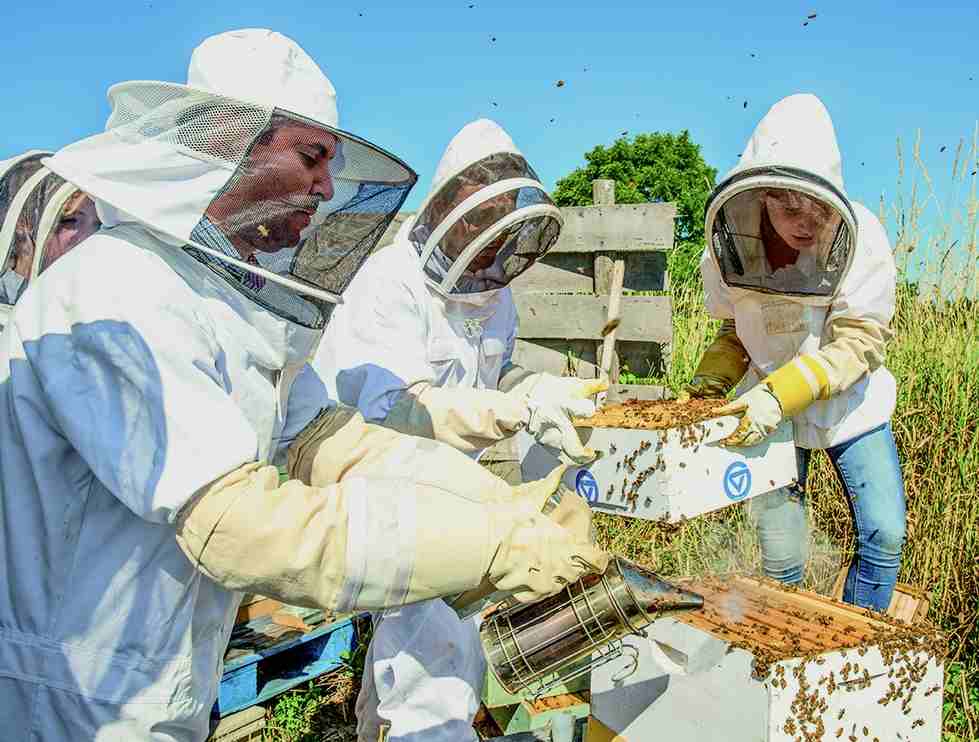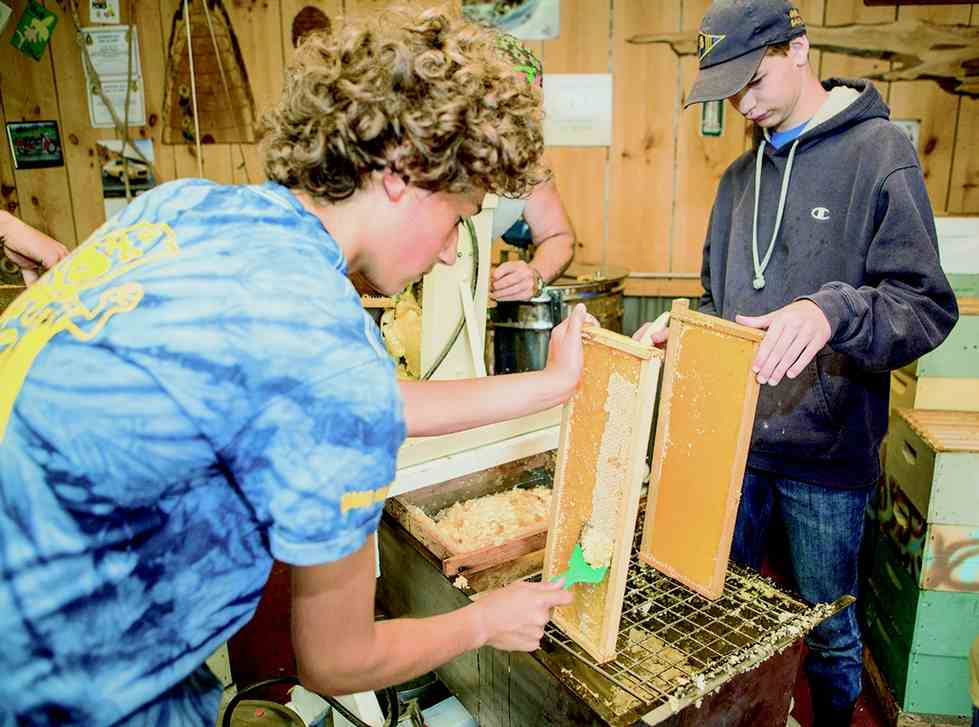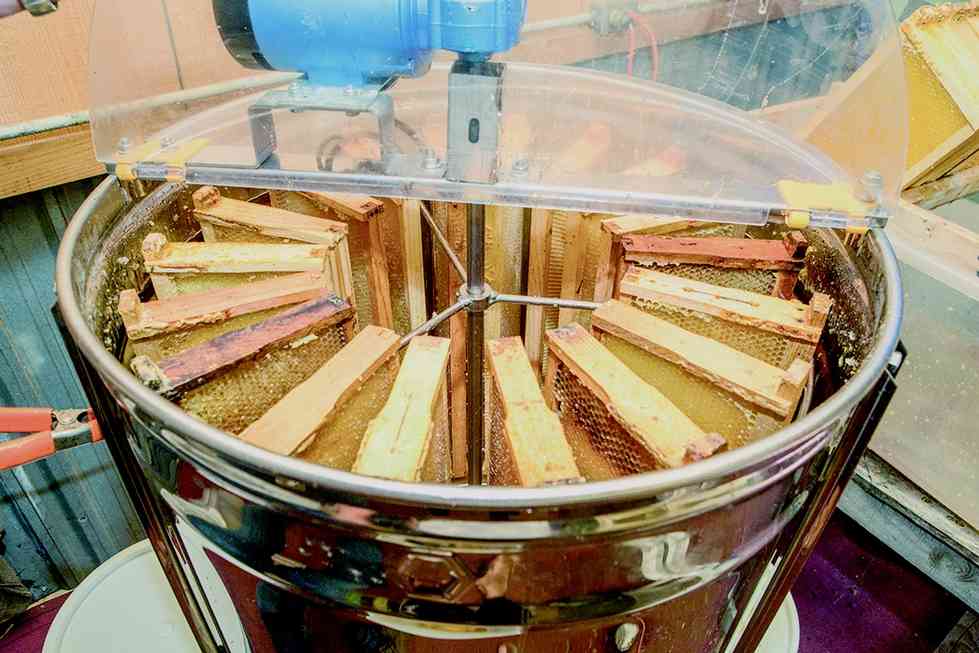Busy as a bee
Students and faculty research, advocate for honeybees
by Leah Twilley
photos by Valerie Wojciechowski
Megan Damico loves honeybees for many sweet reasons. The biggest reason is because the tiny creatures — approximately three-fourths of an inch in size — have such a significant impact on the world.
Damico, a senior biomedical sciences major from Livonia, is president of the GVSU Beekeepers and helps care for the apiaries on campuses in Holland and Allendale. She spent the summer researching bees during an internship at the University of Texas at Austin. She studied a fermentive microbe to determine its use as a possible probiotic treatment for honeybees.

“Honeybees pollinate one-third of crops grown in the U.S.,” Damico said. “They pollinate all kinds of produce, from citrus fruits in the South, up to apples and berries in the North, over to almonds in the West. They’re key to our healthy diets and holding together a natural environment.”
But the honeybees are disappearing and researchers around the world, including Grand Valley faculty members and students, are studying the reasons why. Damico is part of the Grand Valley contingent that is taking a close look at honeybee habitats and health, and organizing community outreach activities to educate people about the species’ importance.
“On average, we lose about 30 percent of hives each year in the U.S.,” said Damico. “I get to blend my passions — honeybees and bacteria — together to save the bees.”
Emily Noordyke, a 2016 alumna who earned a bachelor’s degree in biology, is also working directly with bees as a field technician for the U.S. Geological Survey in North Dakota, a major hub for commercial beekeeping. She’s researching ways landscape changes can impact honeybee health. As an undergraduate, she worked alongside Damico and fellow GVSU Beekeepers members.
Noordyke said as more crops are being produced, more honeybees will be needed to pollinate them.
“That means we will demand more from them, but we’re providing fewer resources for them to thrive, like natural landscapes and diverse forage,” she said.
Bee informed
Researchers suspect the causes of honeybee death are disease and climate. Anne Marie Fauvel, affiliate faculty of liberal studies and president of the Holland Area Beekeepers Association, hopes a mobile app developed at Grand Valley will shed light on honeybee health in Michigan and beyond.
The app is part of Michigan PollenCheck, a four-phase interdisciplinary project led by Fauvel to study bee pollen to project the health of hives in Michigan. The app, part of phase three, was developed by two Grand Valley students and computing professor Jonathan Engelsma. More than 20 beekeepers across the state, from southern Michigan to the Upper Peninsula, have been trained to collect pollen and submit hive data via the app.

After 'robbing' honey from hives, the second step in making honey is to uncap beeswax from honeycomb in frame.
Noordyke, from Ada, created the training videos last year, and worked with Rebekah Suttner, a computer information systems major, to design and build the app.
Bee fact
A typical hive will store a surplus of 100 to 150 pounds of honey.
After data has been collected, Fauvel will connect with Bee Informed Partnership (BIP), a national organization supported by the U.S. Department of Agriculture and the University of Maryland that researches the mortality of honeybees. Fauvel said the app will eventually be used by beekeepers and researchers nationally, in collaboration with BIP efforts. Grand Valley is a BIP partner.
“This summer, the app was used on a smaller scale through beta testing. The testing allowed us to know what revisions and upgrades to make before its national integration,” she said, adding that an Android version is in the works.
Michigan PollenCheck stems from another research project led by Engelsma and funded by a portion of a $2.3 million USDA grant awarded to BIP. The project focuses on collecting data from honeybee colonies using a variety of techniques and tools, including a website developed by a team of students.
The website (hivescales.beeinformed.org) houses information captured by electronic scales that are installed underneath more than 150 live honeybee colonies across the country, including one in Hawaii and two at Grand Valley. The scales capture weight, humidity and temperature every 15 minutes. It allows anyone to remotely monitor the activity at a specific apiary and observe data such as weight increases and drops in hives.
“Every morning when the sun warms a hive, we’ll see the weight drop about four pounds as bees leave to find nectar and pollen,” Engelsma said. “Around midday, we see the weight increase as bees bring nectar and pollen loads back to the hive. Observing weight increases and decreases can reveal a lot of information about a hive; it’s healthy for a colony to gain weight, not lose it.”
Engelsma said student researchers will analyze information from the scales to establish best practices for managing honeybee colonies. He said the next phase of the study is to turn the data into something that’s actionable by providing tools and resources for people in the beekeeping community.
Anyone can participate in the study, including commercial beekeepers, hobby beekeepers and researchers. Engelsma, a hobby beekeeper who manages hives at various locations in West Michigan, hopes to eventually have scales operating in each county in the U.S.
Honey-making process
Honey starts as flower nectar collected by bees. It gets broken down into simple sugars, which are stored inside the honeycomb.
The design of the honeycomb paired with fanning of the honeybees’ wings causes evaporation, which creates honey. When honey is ripe, bees cap each honeycomb cell with a layer of beeswax to preserve it.
Bee inspired
In the early morning of September 1, Damico, Fauvel and students from GVSU Beekeepers outfitted themselves in bee suits, complete with a rounded veil, to “rob the bees.”
“‘Robbing of the bees’ is another way of saying we take, or harvest, honey the bees created and stored during the summer,” said Damico, adding that honey is left for bees to use throughout the winter.
Retrieving and providing honey is a three-step process of harvesting, extracting and bottling. Each year, Fauvel and students retrieve honey produced at the apiaries on Grand Valley’s Meijer
Campus in Holland and at the Sustainable Agriculture Project at the Allendale Campus. This year, more than 360 pounds of honey were extracted from the hives.
A few days later, the group gathered at a house in Hamilton to extract the honey. The home’s owner is Fauvel’s mentor and a member of the Holland Area Beekeepers Association.

Straining honey is one of the last steps in the process.
“Beekeeping is a tradition and a trade,” said Fauvel, “so I’m adamant about including experienced beekeepers and learning from them. There’s a lot of knowledge out there.”
A heated knife was used to remove the top layer of beeswax from each frame. A collection of frames was placed in a large centrifuge that spun around to whip honey from each frame.
Fauvel said a variety of techniques can be used to strain the honey, they used a paint strainer. The honey sat for a few days to allow time for impurities to rise to the top. After the top layer is removed, it is ready to be bottled and consumed. The honey is sold on campus in the Liberal Studies Department located in Lake Ontario Hall on the Allendale Campus, and at the front desk at the Meijer Campus in Holland.
Damico recommends looking at the label before buying honey at stores. She said some bottles will say “pasteurized,” which means a heat process was used to get rid of impurities and complex proteins in the honey.
“This process basically turns the honey into raw sugar,” she said. “Pasteurizing gets rid of medicinal properties that are really good for you. The honey we’re passing on to the community members is raw and 100 percent from the hives.”
